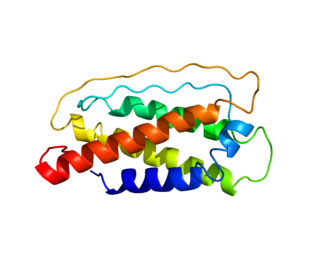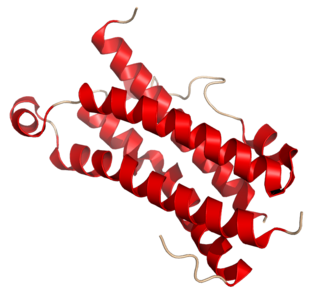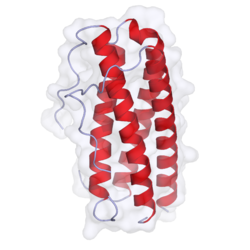
Cytokines are a broad and loose category of small proteins important in cell signaling. Due to their size, cytokines cannot cross the lipid bilayer of cells to enter the cytoplasm and therefore typically exert their functions by interacting with specific cytokine receptors on the target cell surface. Cytokines have been shown to be involved in autocrine, paracrine and endocrine signaling as immunomodulating agents.

Interleukin 6 (IL-6) is an interleukin that acts as both a pro-inflammatory cytokine and an anti-inflammatory myokine. In humans, it is encoded by the IL6 gene.

Interleukin 3 (IL-3) is a protein that in humans is encoded by the IL3 gene localized on chromosome 5q31.1. Sometimes also called colony-stimulating factor, multi-CSF, mast cell growth factor, MULTI-CSF, MCGF; MGC79398, MGC79399: after removal of the signal peptide sequence, the mature protein contains 133 amino acids in its polypeptide chain. IL-3 is produced as a monomer by activated T cells, monocytes/macrophages and stroma cells. The major function of IL-3 cytokine is to regulate the concentrations of various blood-cell types. It induces proliferation and differentiation in both early pluripotent stem cells and committed progenitors. It also has many more specific effects like the regeneration of platelets and potentially aids in early antibody isotype switching.

Interleukin 7 (IL-7) is a protein that in humans is encoded by the IL7 gene.

Oncostatin M, also known as OSM, is a protein that in humans is encoded by the OSM gene.

Interleukin-31 (IL-31) is a protein that in humans is encoded by the IL31 gene that resides on chromosome 12. IL-31 is an inflammatory cytokine that helps trigger cell-mediated immunity against pathogens. It has also been identified as a major player in a number of chronic inflammatory diseases, including atopic dermatitis.

Interleukin 30 (IL-30) forms one chain of the heterodimeric cytokine called interleukin 27 (IL-27), thus it is also called IL27-p28. IL-27 is composed of α chain p28 and β chain Epstain-Barr induce gene-3 (EBI3). The p28 subunit, or IL-30, has an important role as a part of IL-27, but it can be secreted as a separate monomer and has its own functions in the absence of EBI3. The discovery of IL-30 as individual cytokine is relatively new and thus its role in the modulation of the immune response is not fully understood.
Interleukin 27 (IL-27) is a member of the IL-12 cytokine family. It is a heterodimeric cytokine that is encoded by two distinct genes, Epstein-Barr virus-induced gene 3 (EBI3) and IL-27p28. IL-27 is expressed by antigen presenting cells and interacts with a specific cell-surface receptor complex known as IL-27 receptor (IL-27R). This receptor consists of two proteins, IL-27Rɑ and gp130. IL-27 induces differentiation of the diverse populations of T cells in the immune system and also upregulates IL-10.

Interleukin-22 (IL-22) is protein that in humans is encoded by the IL22 gene.

Glycoprotein 130 is a transmembrane protein which is the founding member of the class of tall cytokine receptors. It forms one subunit of the type I cytokine receptor within the IL-6 receptor family. It is often referred to as the common gp130 subunit, and is important for signal transduction following cytokine engagement. As with other type I cytokine receptors, gp130 possesses a WSXWS amino acid motif that ensures correct protein folding and ligand binding. It interacts with Janus kinases to elicit an intracellular signal following receptor interaction with its ligand. Structurally, gp130 is composed of five fibronectin type-III domains and one immunoglobulin-like C2-type (immunoglobulin-like) domain in its extracellular portion.

Oncostatin-M specific receptor subunit beta also known as the Oncostatin M receptor (OSMR), is one of the receptor proteins for oncostatin M, that in humans is encoded by the OSMR gene.

LIFR also known as CD118, is a subunit of a receptor for leukemia inhibitory factor.

JAK1 is a human tyrosine kinase protein essential for signaling for certain type I and type II cytokines. It interacts with the common gamma chain (γc) of type I cytokine receptors, to elicit signals from the IL-2 receptor family, the IL-4 receptor family, the gp130 receptor family. It is also important for transducing a signal by type I (IFN-α/β) and type II (IFN-γ) interferons, and members of the IL-10 family via type II cytokine receptors. Jak1 plays a critical role in initiating responses to multiple major cytokine receptor families. Loss of Jak1 is lethal in neonatal mice, possibly due to difficulties suckling. Expression of JAK1 in cancer cells enables individual cells to contract, potentially allowing them to escape their tumor and metastasize to other parts of the body.

Interleukin 6 receptor (IL6R) also known as CD126 is a type I cytokine receptor.

Interleukin 11 receptor, alpha subunit is a subunit of the interleukin 11 receptor. IL11RA is its human gene.
Interleukin-28 receptor is a type II cytokine receptor found largely in epithelial cells. It binds type 3 interferons, interleukin-28 A, Interleukin-28B, interleukin 29 and interferon lambda 4. It consists of an α chain and shares a common β subunit with the interleukin-10 receptor. Binding to the interleukin-28 receptor, which is restricted to select cell types, is important for fighting infection. Binding of the type 3 interferons to the receptor results in activation of the JAK/STAT signaling pathway.

The Interleukin-1 family is a group of 11 cytokines that plays a central role in the regulation of immune and inflammatory responses to infections or sterile insults.

Interleukin 23 (IL-23) is a heterodimeric cytokine composed of an IL-12B (IL-12p40) subunit and an IL-23A (IL-23p19) subunit. IL-23 is part of the IL-12 family of cytokines. The functional receptor for IL-23 consists of a heterodimer between IL-12Rβ1 and IL-23R.

Olamkicept, also known as soluble gp130Fc or sgp130Fc is an immunosuppressive drug candidate, which selectively blocks activities of the cytokine Interleukin-6, which are mediated by the soluble Interleukin-6. Interleukin-6 is a cytokine, which plays a dominant role in the regulation of the immune response and also in autoimmunity. Furthermore, Interleukin-6 has been demonstrated to be involved in the regulation of metabolism and body weight. Interleukin-6 also has many activities on neural cells. The biochemical principle was invented by the German biochemist Stefan Rose-John and it was further developed into a biotech compound by the Conaris Research Institute AG, which gave an exclusive world-wide license to the Swiss-based biopharmaceutical company Ferring Pharmaceuticals. In December 2016, Ferring and the biotech company I-MAB signed a licensing agreement granting I-MAB exclusive rights in Asia to Olamkicept for the treatment of autoimmune disease.
Hyper-IL-6 is a designer cytokine, which was generated by the German biochemist Stefan Rose-John. Hyper-IL-6 is a fusion protein of the four-helical cytokine Interleukin-6 and the soluble Interleukin-6 receptor which are covalently linked by a flexible peptide linker. Interleukin-6 on target cells binds to a membrane bound Interleukin-6 receptor. The complex of Interleukin-6 and the Interleukin-6 receptor associate with a second receptor protein called gp130, which dimerises and initiates intracellular signal transduction. Gp130 is expressed on all cells of the human body whereas the Interleukin-6 receptor is only found on few cells such as hepatocytes and some leukocytes. Neither Interleukin-6 nor the Interleukin-6 receptor have a measurable affinity for gp130. Therefore, cells, which only express gp130 but no Interleukin-6 receptor are not responsive to Interleukin-6. It was found, however, that the membrane-bound Interleukin-6 receptor can be cleaved from the cell membrane generating a soluble Interleukin-6 receptor. The soluble Interleukin-6 receptor can bind the ligand Interleukin-6 with similar affinity as the membrane-bound Interleukin-6 receptor and the complex of Interleukin-6 and the soluble Interleukin-6 receptor can bind to gp130 on cells, which only express gp130 but no Interleukin-6 receptor. The mode of signaling via the soluble Interleukin-6 receptor has been named Interleukin-6 trans-signaling whereas Interleukin-6 signaling via the membrane-bound Interleukin-6 receptor is referred to as Interleukin-6 classic signaling. Therefore, the generation of the soluble Interleukin-6 receptor enables cells to respond to Interleukin-6, which in the absence of soluble Interleukin-6 receptor would be completely unresponsive to the cytokine.





















